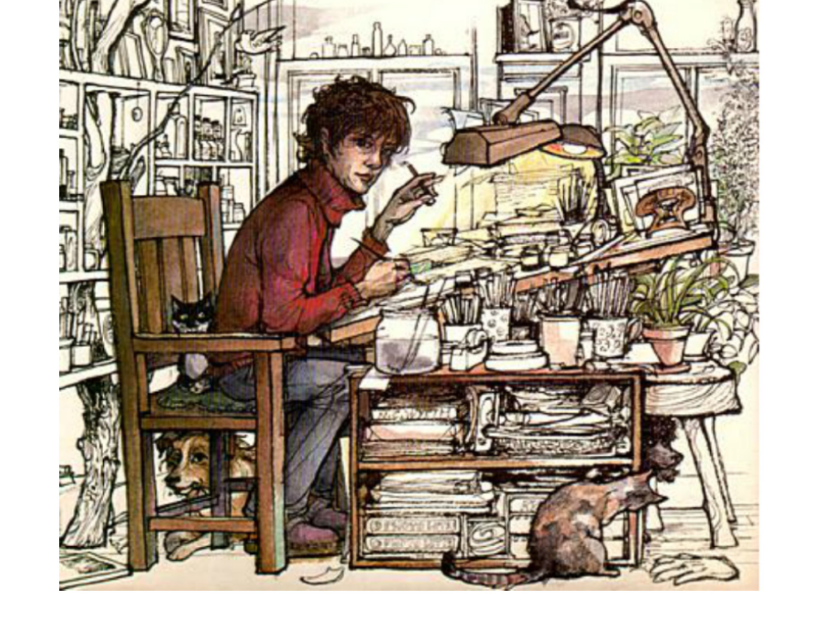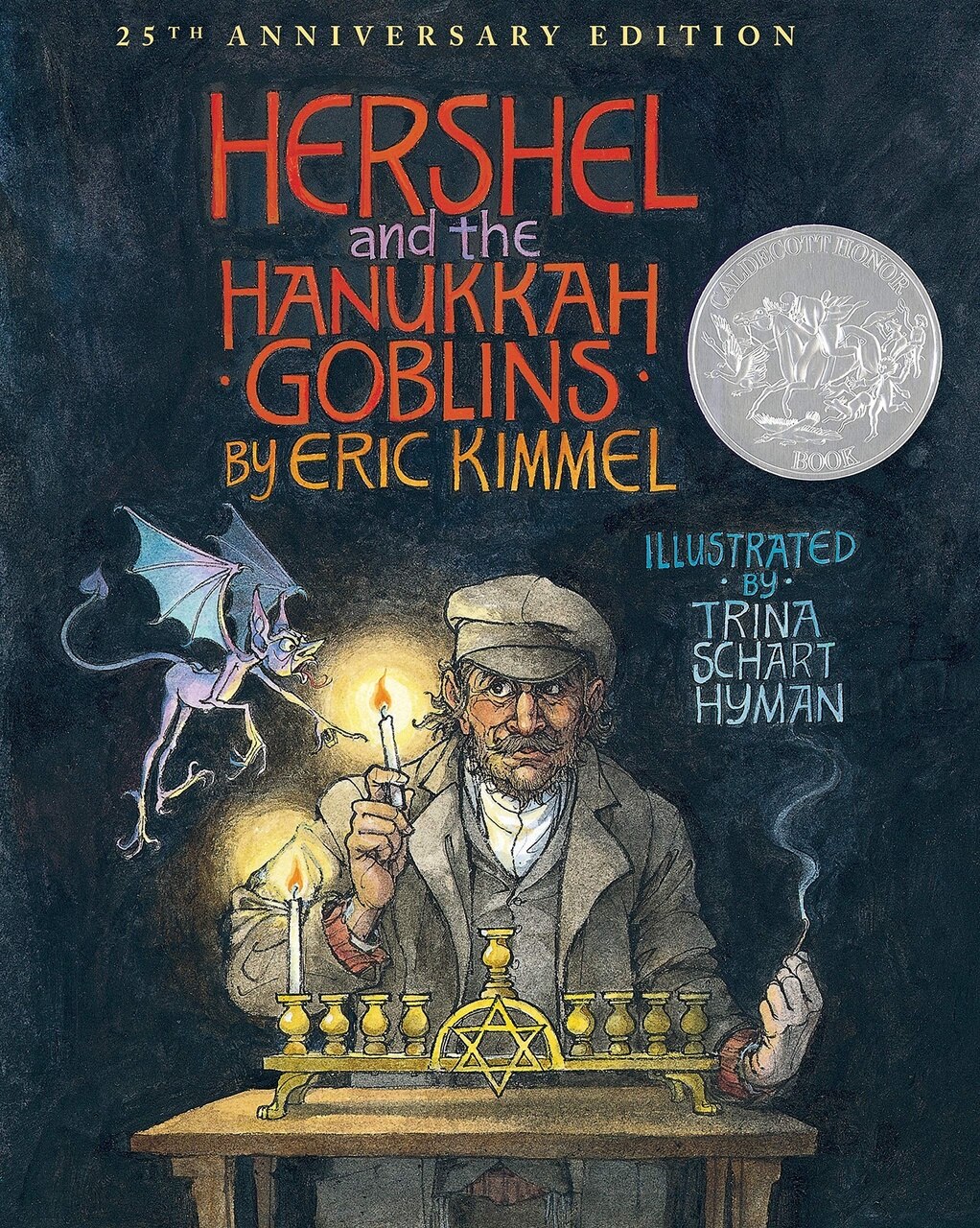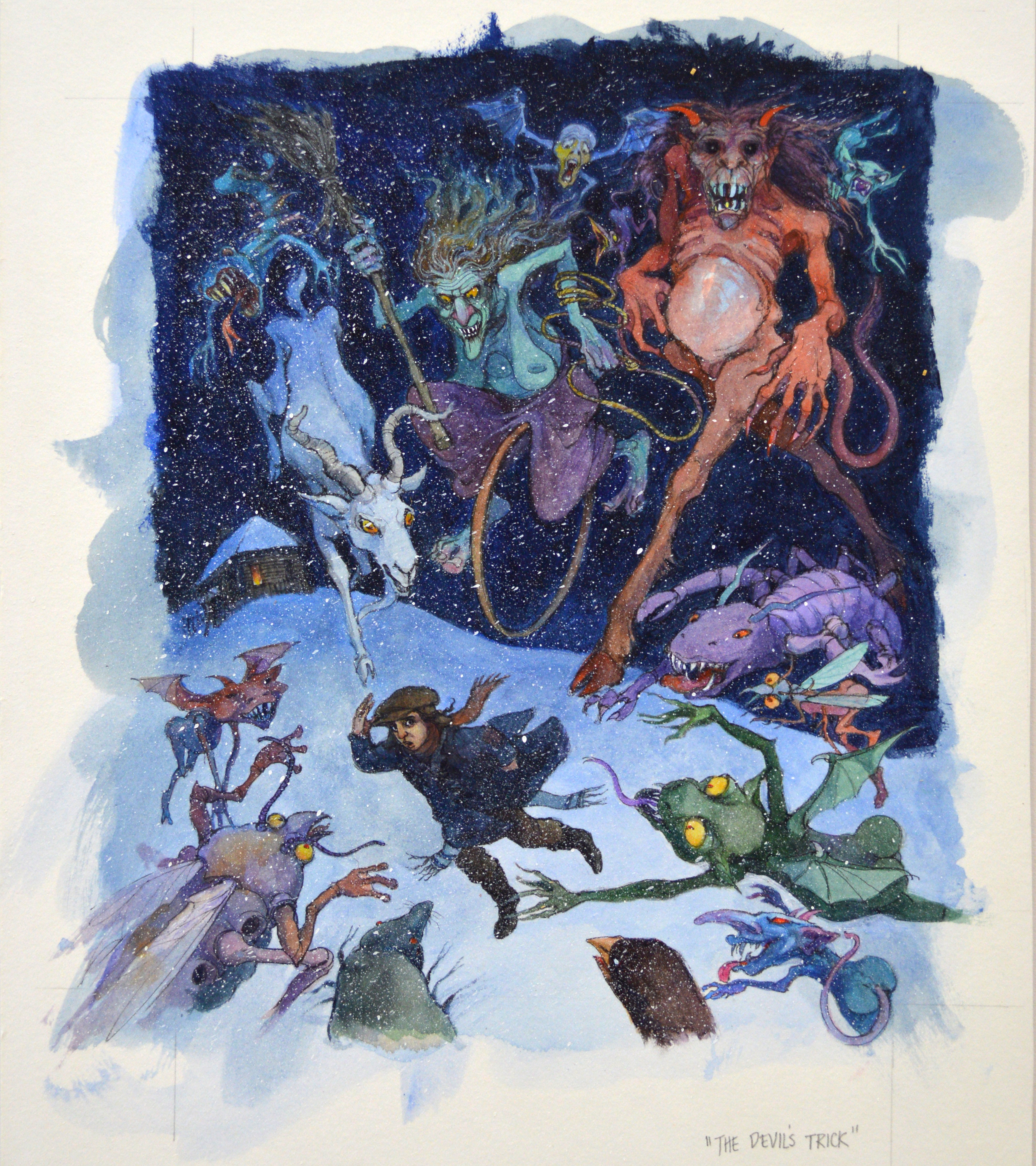
Self-portrait by Trina Schart Hyman. © Trina Schart Hyman, courtesy R. Michelson Galleries.
She was wearing plastic bug antennae and a black leotard when I met her for the first time. “Hi,” she said, coming up to me. “I’m Trina Hyman.”
At the time, Trina was the art director of the acclaimed children’s magazine Cricket; she had invented the famous “bugs” that are still a fixture of the publication. I was nobody from nowhere — a graduate student at the University of Illinois and an aspiring children’s book writer. I’d published a number of stories in Cricket, enough for Marianne Carus, the editor, to invite me to the reception for the magazine at the International Reading Association’s conference in Chicago.
I drove in from Urbana-Champaign and there I was, a mortal among the Olympian gods of children’s literature: writers Lloyd Alexander and I. B. Singer, illustrators Leonard Everett Fisher and Trina Schart Hyman. And here was Trina, whose work I adored, talking to me as if we were old friends, those plastic antennae bobbing around every time she moved her head.
“I know your work. Write something really good and I’ll illustrate it,” she promised before moving on.
____
A decade passed before that happened. Marianne Carus asked if I had a Hanukkah story for the December 1985 issue of Cricket—the deadline was approaching and she needed something right away.
The only Hanukkah story I had was an odd tale that nobody wanted. I’d grafted a Jewish folk hero, Hershel of Ostropol, and the ending of The Wizard of Oz onto a Ukrainian tale about a goblin who lived in a lake. I multiplied the goblin eight times and out came “Hershel and the Hanukkah Goblins.”
I was stunned when I saw the issue. Nobody had told me that Trina would illustrate it. Suddenly, things began coming together.
One of my friends told me, “These illustrations look like a first draft for a picture book. You should write to Trina and ask if she’s interested in doing that.”
Unbeknownst to me, Trina had approached John Briggs, the publisher and owner of Holiday House, to talk about exactly that possibility. She wanted another crack at Hershel — with a lot more room and full color this time.
Meanwhile, Margery Cuyler, who was to become my editor, read the December issue and called John. “I want this story for a picture book.”

Hershel and the Hanukkah Goblins, 25th Anniversary Edition, by Eric Kimmel and illustrated by Trina Schart Hyman
Five years later, I had a career and Trina had a Caldecott Honor Medal.
____
Trina loved illustrating Hershel and the Hanukkah Goblins; it was a vacation from knights in armor and ladies in distress. “Why is it,” she once exclaimed, “that whenever someone writes a story about knights, ladies, and dragons, they send this shit to me?”
Drawing a schnorrer and a host of grotesque bad guys was a cherished vacation for her. She put a lot of herself into those illustrations. The mountains in the beginning of the story are the White Mountains of New Hampshire she could see from her house. The villagers are based on friends from Lyme and Hanover. At least one of the goblins was inspired by a personal encounter as well — the red goblin with the noses whom Hershel challenges to a dreidel game.
Drawing a schnorrer and a host of grotesque bad guys was a cherished vacation for her. She put a lot of herself into those illustrations.
Where did that big nose with all the little noses on it come from? All I’d written about the goblin was that he had a fiery red face and two enormous horns.
“That’s really weird,” I told Trina.
“You think the picture is weird. You should have seen the nose in real life.”
“You saw a real person with a nose like that?”
“Better believe it. I once took a vacation in Normandy. I stopped at a small town to get gas. The man at the gas station came out, and I just stared. He had this big red drinker’s nose with all these little baby noses on it. I felt so sorry for the poor man. Imagine going through life with a nose like that. But the artist in me also said, ‘I can use this.’ So after I filled my tank, I drove down the road a few miles, pulled over, took out my sketchbook, and sketched the nose so I wouldn’t forget it. And when I first read your story, I knew at once: that’s where the nose goes! So in it went.”
____
What most people don’t understand about the Caldecott Medal is that it’s for illustration. The artist gets the medal. The author gets invited to the dinner. That’s it.
In 1990, Trina received the Caldecott Honor Medal for her illustrations for Hershel. At the ceremony, we sat side by side in the audience. It was quite a year. Ed Young won the Medal for Lon Po Po. Lois Lowry took the Newbery for Number the Stars.
“The Honor Medal is the one to get,” Trina whispered to me. “If you win the award, you have to sit up on stage with all these people staring at you. And you have to write a speech. It’s much better to be down here. Less pressure.”
She studied Ed Young. “How do you suppose he works, Eric?”
“He puts on a beautiful silk robe and sits cross-legged on the floor before a scroll of handmade paper. He meditates for hours. Then he takes his brush and — zip, zip — the painting is done.

“The Devil’s Trick” from The Adventures of Hershel of Ostropol. © Trina Schart Hyman, courtesy R. Michelson Galleries. Trina Schart Hyman original illustrations are available at R. Michelson Galleries.
“I think you’re right,” Trina said. “Wish I could do it that way.”
Years later I asked Ed about his process. “No,” he said, “I don’t work that way at all. I wish I could, though.”
I don’t remember what we had for dinner, but I do remember the dessert. It was a sort of large ice cream éclair. Quite good, actually. I ate mine. And Trina’s, too. She thought it was disgusting.
The next day, after autographing, Trina was approached by one of the committee organizers who asked if she enjoyed the dinner.
“Oh, yes,” Trina said. “Especially the dessert. It looked like a large chocolate penis.”
Which, to tell the truth, was a fair description.
____
Trina and I worked on other projects over the years. She illustrated The Adventures of Hershel of Ostropol, a collection of Hershel stories, and Iron John, one of our favorite tales by the Grimms.
There was a time when I ran into some troubles. I won’t go into details. The result was endless sleepless nights and stomach churning. Finally, at three o’clock one morning, I knew I had to talk to someone.
I live in Oregon. It was a few hours later in New Hampshire. I took a chance and called Trina. Maybe she’d hang up on me. Maybe she’d let me have it for bothering her so early in the morning. And what did my troubles have to do with her, anyway? It wasn’t as if we were intimate friends.
All the same, I had to take the chance.
Trina picked up. “Hi, Eric!” she said in that wonderful slow drawl of hers. “What’s going on?” She knew in a moment that something wasn’t right.
“Trina,” I began, “I’m in big trouble and I need to talk to someone. You’re the bravest person I know. Can you spare a few minutes to listen?” She was indeed the bravest person I knew, having recently come through a cancer scare with her sense of humor and optimism intact.
She was indeed the bravest person I knew, having recently come through a cancer scare with her sense of humor and optimism intact.
I told her my story. She listened, then said, “Listen, Eric. I know this is scary for you now. It’s really nothing in the big scheme of things. Do you want to know what’s going to happen? We live. We die. And in the middle we have some good times and some bad times. That’s your story. That’s my story. That’s the story of everybody who ever lived and whoever is going to live. You just hope that when the end comes, it will be quick and won’t be too painful.
“As for what you just told me, it will work itself out. The best result you’re hoping for probably won’t happen. But neither will the worst. It will end up somewhere in the middle. It’s all about money anyway, which is not that big a deal. You’ll write a check and that will be the end of it. Life moves on and so will you. I promise that the next time we get together we’ll have a drink and laugh about it.
“There’s one more thing I want you to remember while you’re going through it all. Pills help. So does booze. And so do friends. So use them.”
Trina was right in every regard. And a year later — just as she’d promised — we had a drink and laughed about it.
____
The last book Trina illustrated was written by her daughter, Katrin Tchana. It’s called Changing Woman and Her Sisters: Stories of Goddesses from Around the World.
Trina’s illustrations were a labor of love. She showed me some of the original paintings once when I visited her studio. Breathtaking.
And tragic. Because some of the pictures I saw are not the pictures that appear in the book.
Several of the goddesses in the original illustrations were bare-breasted. It was Trina’s way of celebrating herself as a woman, as an artist, and as a lesbian, and of thumbing her nose at anyone who refused to accept her as she was. It was a celebration of all women of every culture, race, and nationality.
So why are the pictures in the book different?
Trina was dying when she created the original paintings. Her cancer had come back and was spreading. Every hour at the easel was a battle against time.
She presented the artwork to her editor, who gave it to Trina straight: “It’s a magnificent book. But given the times we live in, the bare breasts are a problem. I won’t tell you what to do. If we keep them in, it will be an art book and sell 5,000 copies — maybe. If we cover them, the sky’s the limit. We may have a major book, an award winner. You decide. I’ll back you in either case.”
Trina had no strength left for a fight, and she wanted Katrin to have a successful book. She gave in.
The compromise turned out to have been in vain. The original publisher canceled the project, and the book was eventually published by Holiday House, where Kate and John Briggs were among Trina’s closest friends and supporters.
What might have been.
____
I don’t want to close on a sad note because that wouldn’t be Trina.
I remember one time in the mid-nineties when we were in San Francisco for a conference. As we walked back to our hotel, the Gay Pride parade went right by us.
Nowadays Pride parades take place in every major city in the country, but at the time, they were much less common. The pièce-de-résistance were the Dykes On Bikes: bare-breasted women with shaved heads, Brunhilde braids, and tie-dyed mohawks, painted all over with every color and design imaginable, roaring past on huge motorcycles.
I stood gawking. I’d never seen anything like it.
Trina didn’t bat an eye. After the parade passed, she gave me a wicked grin and said, “Did you see that, Eric? There are a lot of us.”
Trina wasn’t wrong about much, but she was wrong about that.
There was only one Trina.
I miss her every day
Eric A. Kimmel is the author of more than a hundred books for children, including the classic Hershel and the Hanukkah Goblins and more recently Little Red Rosie: A Rosh Hashanah Story and Big Sam: A Rosh Hashanah Tall Tale. He is the only author to have won the National Jewish Book Award five times for The Chanukkah Guest, The Mysterious Guests: A Sukkot Story, Wonders & Miracles: A Passover Companion, The Golem s Latkes, and Hanukkah Bear. The Association of Jewish Libraries has awarded him the Sydney Taylor Lifetime Achievement Award.